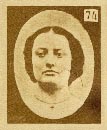

" To render more evident the modifying influence of a single expressive muscle over all the other features, I have often contrasted a voluntary expression on one side the face photographed, with an artificial expression, determined by electrical contraction, on the other side of it. In these electro-physiological studies, I give my subject an attitude- and gesture in harmony with the physiognomic expressions which I wish to produce; then I ask her to execute the facial movements proper to these expressions, as I conceive them, but without any intervention of her feelings. Thus, I give such or such an attitude to the head, I cause her to turn her eyes in such or such a direction, to close or open the eyelids, to open the mouth more or less, to laugh, or smile, etc. So I obtain the expression such as I wish, such as I feel it ought to be, in so far as this is possible by the employment of those muscles which obey the will. All expressions cannot be thus produced, because the muscles essential to them do not even partially obey the will, but contract only under the reflex excitement of passions, or else under the influence of localized- electrization. At the moment when the expression produced by the voluntary movements is well obtained and imparts its character to the whole face, I excite upon one side or upon both sides the electrical contraction of one or of several muscles, whose special expressive action modifies or completely changes the voluntary expression. Armed with my rheophores, it is not sufficient to excite exactly the muscles whose individual action produces the lines, the reliefs, and the modelling characteristic of the passion or intellectual state which I wish to render; I must, moreover, cause its different degrees to be felt, and accentuate its infinitely varied shades, without falling into exaggeration or grimace.
" Camper has stated that the folds and wrinkles of the face are necessarily perpendicular to the direction of the muscles, viz.:
" The commissure has been moved by the great zygomatic, and the naso-labial furrow has been hollowed by the special elevator of the upper lip and nose. The radiating wrinkles next the external angle of the eye are due to the sphincter of the eyelids.
" Now, my experiments refute this view, and show that the great zygomatic alone produces all these wrinkles and furrows. The same principle applies to most of the expressive muscles of the face. We are not, then, to infer from a wrinkle occasioned by any expressive movement, that the muscle which crosses it is in contraction."
The higher up a muscle is located in the face, the more complete is its power of expression in partial contraction.
The elements of a given expression are composed of fundamental lines, which are their pathognomonic signs, and of lines which we may regard as secondary. The latter may sometimes be absent, but, whenever they appear, it is only as satellites of the former, to add to their signification.
If we pull either directly or obliquely upon a point of the upper border of a curtain, we see folds varying in their position and direction with the resistance of the stuff as it may be stiffer or suppler. So, when the skin is drawn at any point of the face in a particular direction, we see wrinkles furrowed on its surface in divers directions and in parts more or less distant from each other. This surface is not smooth when in repose, but shows furrows and reliefs due to the tonic predominance of such or such a muscle of this region, and varying according to the age of the subject or to the play of those habitual passions which constitute the individual physiognomy. Any traction limited to one point of the face modifies these furrows and reliefs; it may exaggerate them, may efface them, or may change their direction. Let a force act in the direction of the commissure of the lips outside the cheek-bone, like the great zygomatic, then the naso-labial furrow is hollowed; its curve becomes sinuous, and wrinkles radiate around the outer angle of the eye.
The large frontispiece figure (Plate I.) shows the expression of glee produced, by exciting the greater zygomatic muscle, upon an old, stolid, and insensible face. To complete this expression in kind, the muscles of both sides must be excited, in connection with the " orbicular " fibres of the lower eyelids, which contract in a horizontal depression beneath the eyes. This is missing in a false or simulated mirthfulness.
